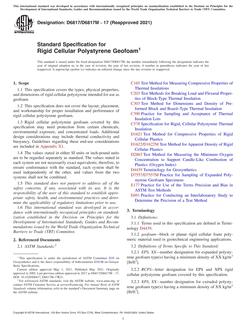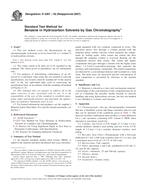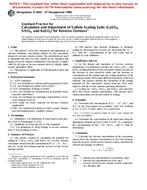1.1 Residual Stress Determination:
1.1.1 This test method specifies a hole-drilling procedure for determining residual stress profiles near the surface of an isotropic linearly elastic material. The test method is applicable to residual stress profile determinations where in-plane stress gradients are small. The stresses may remain approximately constant with depth (“uniform“ stresses) or they may vary significantly with depth (“non-uniform“ stresses). The measured workpiece may be “thin“ with thickness much less than the diameter of the drilled hole or “thick“ with thickness much greater than the diameter of the drilled hole. Only uniform stress measurements are specified for thin workpieces, while both uniform and non-uniform stress measurements are specified for thick workpieces.
1.2 Stress Measurement Range:
1.2.1 The hole-drilling method can identify in-plane residual stresses near the measured surface of the workpiece material. The method gives localized measurements that indicate the residual stresses within the boundaries of the drilled hole.
1.2.2 This test method applies in cases where material behavior is linear-elastic. In theory, it is possible for local yielding to occur due to the stress concentration around the drilled hole, for isotropic (equi-biaxial) residual stresses exceeding 50 % of the yield stress, or for shear stresses in any direction exceeding 25 % of the yield stress. However, in practice it is found that satisfactory results can be achieved providing the residual stresses do not exceed about 60 % of the material yield stress.
1.3 Workpiece Damage:
1.3.1 The hole-drilling method is often described as “semi-destructive“ because the damage that it causes is localized and often does not significantly affect the usefulness of the workpiece. In contrast, most other mechanical methods for measuring residual stresses substantially destroy the workpiece. Since hole drilling does cause some damage, this test method should be applied only in those cases either where the workpiece is expendable, or where the introduction of a small shallow hole will not significantly affect the usefulness of the workpiece.
1.4 This standard does not purport to address all of the safety concerns, if any, associated with its use. It is the responsibility of the user of this standard to establish appropriate safety and health practices and determine the applicability of regulatory limitations prior to use.
Product Details
- Published:
- 02/01/2008
- Number of Pages:
- 17
- File Size:
- 1 file , 330 KB
- Redline File Size:
- 2 files , 700 KB


